danbricklin.com/log
|
||
|
|
Starting March 9, 2011
Steve Jobs at WWDC 2011, Video of walking through Fall Comdex 1983, Steve Jobs talking about VisiCalc, Tablet technology and special needs, Garden Utils for Programmers,Entrepreneur Walk of Fame, Note Taker HD version 5 -- a real productivity app on the iPad
09Mar11-07Jun12
2011_03_09.htm
|
|
|
Steve Jobs at WWDC 2011 [link]
I saw a tweet that reminded me that it's one year (and a day) since Steve Jobs hosted his last keynote at the Apple World Wide Developers Conference. Sigh. I had the privilege to attend that event and even have a pretty good seat for a non-press, non-VIP, non-Apple person. (I got in line at about 2:30 am -- position about #150 out of thousands.) Through complete luck, I had the fortune of running into him soon after he came off stage, and spoke to him 1-on-1 for a minute right before he went over to see his wife. (It was the first we spoke in decades.) He then spent a long time hanging out with other attendees, and then finally left. This was the last time I know of him being in a "public" setting with the Apple world of developers, etc.
Here are two photos I took:
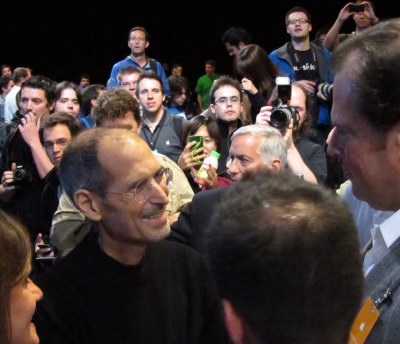 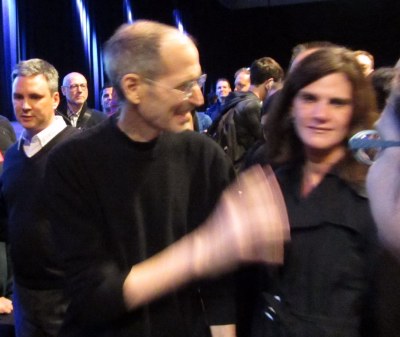 Steve Jobs at the Apple WWDC June 6, 2011
If anybody reading this happens to have a photo of me talking with Steve that morning, I'd really appreciate a copy.
Video of walking through Fall Comdex 1983 [link]
I put up the full 1 hour and 25 minute video of walking around the Comdex trade show in the fall of 1983. I also put up a few excerpts as a much shorter video. The full tape includes Bill Gates discussing Microsoft's usage of their Unix variant Xenix with Lotus' Jonathan Sachs, a demo of the early integrated program Context MBA, a long section in IBM's PC Jr. demo room, Wang's Professional Imaging Computer system, Apple showing a mouse and a paint program on an Apple II before the Mac was announced, and a full demo of the just-announced Microsoft Windows years before it first shipped. There are short views of computer after computer in a myriad configurations in the days of MSDOS. The snippet of Bill Gates was shown (without sound) on PBS's Triumph of the Nerds -- now you can hear what he said.
Steve Jobs talking about VisiCalc [link]
This week marked the 35th anniversary of the first public showing of the Apple II. To help mark it, I posted a short interview with Steve Jobs where he talked about the importance of the spreadsheet VisiCalc to its success.
See "Steve Jobs talking about VisiCalc in 1996" for more information.
Tablet technology and special needs [link]
When my father died two years ago, we, his family, asked that any donations that were made in his memory go to a new fund at a Massachusetts non-profit. The non-profit is Gateways, an organization that provides Jewish education to children who have special needs that block their ability to get it otherwise. One of his grandchildren has autism, and other family members have been involved in Special Education and Jewish education in various ways, so this fit well with honoring his memory.
Now that it's the two-year anniversary of his death, we've had some time to see what the effect of that fund has been. We can see the success they've had using recent technology, and iPads in particular, to facilitate the education of children with challenging disabilities. They are moving ahead to more widely deploy that technology now that it is proven.
I think that what they have found is generally of interest: The modes of interaction brought to general use by devices like the iPad open up doors that were previously closed to these children. Gateways has found that spending money on tablets, their software, and accessories is like a carpenter spending money to buy hammers and saws: Basic tools that makes your mission possible. While this is in the area of special needs, I am certain that it is another example of how new modes of interaction are opening up new ways that computing power can make us all more able.
I've written the whole thing up in an essay: "Baruch Bricklin Dor L'Dor Fund".
Garden Utils for Programmers [link]
Another long pause on the blog while I worked on Note Taker HD. Versions 6.5 and 6.6 have come out, adding more features. Also, there is a complete do-over of the support web site, www.NoteTakerHD.com. As usual, anything timely shows up on my Twitter stream, @DanB, and photos on my Flickr stream.
I've also finally moved my old blogging tools, an ancient copy of Trellix Web, to my current Windows computer (a big Lenovo laptop with a 1920x1080 screen and a great keyboard). For about 10 years, I've been using an old Dell 4500 for Trellix (my main development machine for everything I've done that wasn't for iOS), and then a Toshiba Portege tablet PC, and then an Acer netbook. The Dell is on its last legs, the Toshiba has a dead screen (I'm using an external one now) and a failing disk, and the netbook has too little power and too small a screen. Trellix doesn't run on my Apple systems (and I don't run Windows on those). This has cramped my blogging a bit. Now I feel empowered again.
For various reasons, I just released a simple iPhone/iPod touch/iPad app. It's called Garden® Utils for Programmers. It provides a variety of utility functions that can be helpful for programmers and web developers. The choice of features came out of what I needed as well as what were easy to add in the short time I allotted for its development. It does decimal / hex / RGB / RGBA conversion and shows the characters for ASCII and Unicode values. It lets you quickly choose and view some documentation files. It does hex dumps of files. It can zoom in on an image file and display the coordinates and color values of individual pixels. It lets me get some practice with providing up to date data for a mobile app. It also can serve as a platform for me to test out new code in the lab and in the field before shipping it in Note Taker HD (which is much more complex and where bugs can have a more problematic effect for me and users).
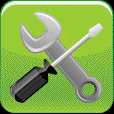 You can learn more about Garden Utils for Programmers, and see a video of it in action, on the www.GardenUtils.com web site.
Entrepreneur Walk of Fame [link]
Boy, it's been a long time since I last added to this blog. Getting version 6 of Note Taker HD out was a long process and took up pretty much all of my time. I was trying (ultimately successfully) to get a major revision of the data storage and UI completed, tested, released, and then re-released with the inevitable missed major bugs fixed before I left the country for 2 weeks to attend a wedding, visit relatives, and tour a bit.
As my life is returning to normal (there have been a few other family events filling things in) I received a call asking me to give an unusual speech. Bill Gates was being honored in Cambridge, Massachusetts, and the organizers, with Bill unable to attend, asked me to speak on his behalf.
They were starting an "Entrepreneur Walk of Fame," complete with stars in the sidewalk, in Kendall Square, the hotbed of innovation. I agreed to do it, joining Lotus founder Mitch Kapor (who was also being honored along with Bill and the other honorees Apple's Steve Jobs, Bob Swanson of Genentech, Bill Hewlett and David Packard of HP, and Thomas Edison who founded companies that became GE), Dan Lyons (the "fake Steve Jobs" and Newsweek writer standing in for Steve), and the great-grandson of Thomas Edison.
There were seven people inducted in this first "class" of the Walk. The criteria for that first set included starting a business that grew to over $1 billion in valuation and being mainly in the United States. That helped narrow the choices down a bit. I understand that choosing was quite hard for the committee, but the people they chose were clearly ones that would eventually end up being chosen at some point anyway and that people visiting the Walk would expect and find logical. They purposely wanted some still alive and some not.
The stated purpose of the Walk is to help inspire future entrepreneurs at nearby colleges (MIT, Harvard, Boston University, Northeastern, and more) and serve as role models. That made my speech challenging in that I wanted to focus on things to emulate not just on financial success (though we were asked to explain the general accomplishments, too). Each star in the ground is accompanied by a quote from that individual, and we needed to tie into that, too.
Given that we had a very rigid time slot because of potential TV coverage (10 minutes each), and my desire to be as clear as possible about my points, I decided to read my speech from prepared text. (That also means I can just reproduce it here without transcription.) I've had some requests to post it, which I did.
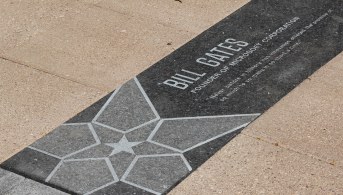 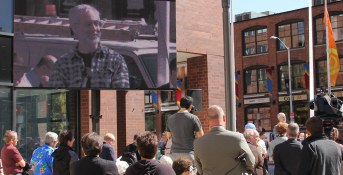 One challenge I had was being balanced about Bill. There are things that I, and other people in the software industry, think should be emulated by others and some that perhaps should not be celebrated. I hope I struck the right balance, standing there a few blocks from a major competitor (Lotus/IBM) and the ghosts of others and the cradle of Free Software.
You can read my prepared remarks (which are pretty close to what I actually said) on "Dan Bricklin's Remarks about Bill Gates at the Entrepreneur Walk of Fame event September 16, 2011".
For the last year or so, instead of taking the time to edit down to just a few pictures and put them here, or painstakingly creating an "album" for posting, I've just been posting almost all of the photos I take on Flickr.com/danbricklin. Others can look at them all, and choose which ones they want to share or use (I tag them with a Creative Commons license I feel is appropriate). You can see the photos from this event on my "set" for it, "Entrepreneur Walk of Fame Unveiling 2011-09-16". The photos of me were taken by Bob Frankston and Marv Goldschmitt (both of whom were once at Lotus -- a lot of ex-Lotus people came to honor Mitch).
Note Taker HD version 5 -- a real productivity app on the iPad [link]
An important use of personal computing for the last 35 years has been to give people the ability to use productivity applications. These applications are general purpose programs used by regular people of all sorts to help them get their work done.
The three classic early productivity tools are the word processor, the spreadsheet, and the presentation graphics tool -- the basis of many "office" bundles. People use them to express themselves, for putting their thoughts and ideas "down on paper", both for their own use and for sharing with others, and as aids to help them do those tasks betters. The programs provide a framework and functionality for doing that expression that also takes care of much of the tedious repetitive work, such as re-wrapping text and recalculating formulas. They do the detail work, such as drawing straight lines and boxes, and give a means for storing and retrieving the "documents" produced. Those frameworks were designed to feel "natural" and comfortable to use, not getting in the way of your thinking.
I've been developing productivity applications most of my career. In the mid-1970s I helped develop the WPS-8 word processing system at DEC. This was a very early WYSIWYG screen-based word processor, later sold on new hardware as the DECmate. It predated the later popular dedicated word processors from Wang and others, and the major personal computer word processors like WordStar, MultiMate, WordPerfect, and the later Microsoft Word.
In the late 1970s I developed VisiCalc, the pioneer of what we now call spreadsheet programs. In the early 1990s I worked on productivity programs for the emerging pen-based tablet computers of those days, including a spreadsheet and a drawing (ink) based "Day-Timer" personal organizer. In the late 1990s and early 2000s I worked on web authoring tools for regular individuals. For the rest of the last decade I worked on browser-based spreadsheets, including the one used in Socialtext's enterprise-level social software and the One Laptop Per Child's XO computer being used around the world.
That's a long history in the productivity field, not including my work in the pre-personal computer timesharing days.
For the last year and half I have been developing notetaking software for first the Apple iPhone and then later the Apple iPad. This type of software lets you "write" on the screen with your finger or a compatible stylus and store "ink" as if you were writing on paper. For the last year, that work has been exclusively for the iPad through a popular app called Note Taker HD.
The initial versions of Note Taker HD were focused on letting you write on the screen and produce pages of notes that were very similar to those you could produce with a fine pen. That alone was a major feat. You could output those pages as PDF files for printing or emailing, and you could easily retrieve them using a gallery of thumbnails, tags, and other sorting techniques. However, other than those capabilities and letting you have a lot of notes without too much weight, there really wasn't that much advantage over regular paper. (For some people, those were important advantages.)
From the first, one of the special things about Note Taker HD (inspired by my iPhone Note Taker app before it) was how it let you write with large strokes more appropriate to a touch screen than the tiny motions you'd use with a pen on paper. That ink would then automatically shrink down to look like fine printing or writing. The results were often indistinguishable from a scan of pages created with a real pen and paper.
The release in late November 2010, version 4.5, added the ability to import PDF files and use the ink for writing on top of those pages for annotation, editing, and even the signing of documents. This ability to save the step of printing to paper to get the flexibility of freehand handwritten and hand-drawn markup at the resolution of traditional pages of text made the app even more valuable.
I've recently released version 5 of my iPad app, Note Taker HD. This version finally brings the app into the realm of a full-fledged productivity tool. It adds the ability to type blocks of text, insert shapes from an extensive gallery, insert images and photos, and move and modify existing ink. You can easily produce pages that are of the level you'd expect from a desktop app with the added flexibility of being able to use handwritten and hand-drawn material.
Given my background in productivity tools, I made sure that the new features had a lot of productivity-enhancing control. For example, the blocks of text have attribute settings not just for font and color, but also to control a border around them, the padding, the vertical alignment, and the fill color.
The 40+ predefined shapes are very customizable.There are simple shapes like a rectangle. By tapping a button the rectangle can be constrained to a square when resized, and there is a slider to control the amount of curve in the corners and there is another slider to rotate it. The rectangle can contain text which rotates, too. There are complex shapes like an X/Y axis, with sliders to control the grid style (horizontal lines, vertical lines, both lines, thicker every 5 lines, etc.) and the spacing between those lines. The images have optional outlines and captions.
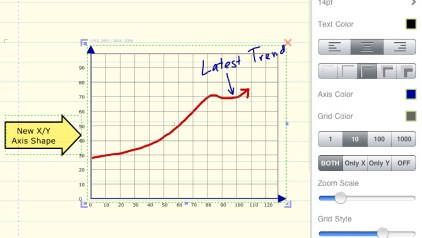 Close-up of a selected shape being customized
I'm really excited about this release. The previous versions have been used by medical students, lawyers, kids with disabilities, contractors, teachers, and business people. Listening to their requests, and using my years of experience with productivity tools, I've added these new features to let them go further with a tool that they have already made a staple of their work or study day.
It is a real wake up when you feel the power of control the iPad gives you literally at (and by) your fingertips to create what previously took a personal computer and pens and paper. And, with the right adapter, you can do all of this while projecting on a screen to include others while you do it, and then email them the results.
I do all of my own programming, getting help only for graphic and UI design from family and friends (and lots of help from beta testers around the world). In the case of this release, most of the shapes were designed and specified (using the capabilities I built into the app) by my nephew, Mike Rzepka, an artist who had to try to remember his High School math and computer classes to get the job done.
After the months of work that I put into it, the reception for this new version has been quite gratifying to me. You can see it in action by watching the videos on the Note Taker HD Youtube channel, including the Overview of Note Taker HD video. (It's even better if you make sure you have Youtube set to watch it in HD.)
Some related writings of mine:
About general purpose tools: When The Long Tail Was The Dog, and Metaphor, Not Conversations.
About the iPad: Is the Apple iPad really "magical"?
|
||
|
© Copyright 1999-2018 by Daniel Bricklin
All Rights Reserved.
See disclaimer on home page.
|
||